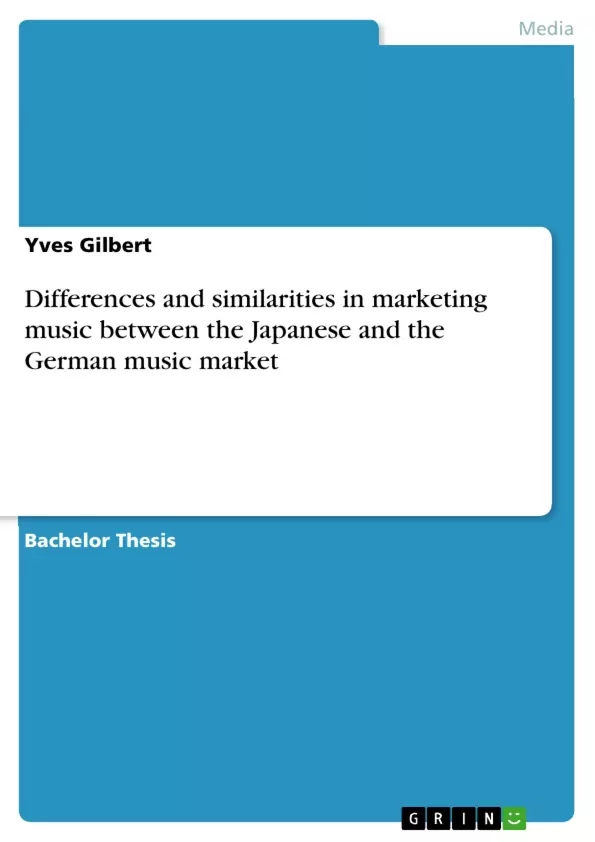Five years before starting my studies at the University of Applied Sciences Bremen, I absolved an apprenticeship at Warner Music Germany, one of the leading major music labels. During these 2 ½ years, I gained a thorough insight of the various departments a record label has to offer such as TV, radio and press promotion, A&R as well as licensing and retail. I continued working for Warner Music after graduation and put my gained knowledge to good use.
My interest for music and the music industry in general didn’t end when I chose to study Applied Business Languages (emphasis Japanese) and International Management in Bremen, and during my yearlong stay in Japan, I couldn’t help but notice the abundance of pop music “made in Japan” and some peculiar differences on how music seemed to be promoted.
Why shouldn’t there be differences anyway? Japan is unlike the rest of the world in so many ways, why shouldn’t this be the case for the music business? This train of thought led to the subject of this bachelor thesis.
In order to compare the promotion tools of both markets, it is important to gain an overview of both music industries first: chapter three defines the current status as well as some of the characteristics of the Japanese and German music market.
Chapter four takes a closer look at the marketing mix and presents the most important promotion methods used in Japan while comparing these to the German market such as testimonials and the tie-in system. It also gives examples of new ways of advertising both in Japan and Germany.
The next chapter deals with the empiric research conducted for this thesis in order to support and/or disprove the claims and observations made in the previous chapters. Possible reasons for the differences between theory and practice are presented as well.
Last but not least, chapter six sums up all important information about the differences and similarities in a nutshell.
Inhaltsverzeichnis (Table of Contents)
- 2. introduction
- 3. the Japanese and the German music market: overview
- 3.1. comparing the current status
- 3.2. characteristics of the Japanese music market
- 3.2.1. the trend evolution velocity
- 3.2.2. fan following in Japan
- 3.2.3. the idol industry
- 3.2.4. otaku
- 3.2.5. domestic vs. international repertoire
- 3.2.6. karaoke
- 3.2.7. CD rental shops
- 3.2.8. ringtones / chaku uta
- 3.3. music diversity
- 3.3.1. domestic repertoire
- 3.3.1.1. enka
- 3.3.1.2. kayokyoku
- 3.3.1.3. J-pop
- 3.3.1. domestic repertoire
- 4. advertising
- 4.1. defining the term marketing mix
- 4.2. one of 4 Ps: Promotion
- 4.3. media and its role regarding advertising in both countries
- 4.3.1. television
- 4.3.2. radio
- 4.3.3. press
- 4.3.4. internet
- 4.4. testimonials
- 4.4.1. definition
- 4.4.2. use of testimonials in Japan and Germany
- 4.5. the tie-in system
- 4.5.1. definition
- 4.5.2. TV tie-ins in Japan
- 4.5.3. TV tie-ins in Germany
- 4.6. the influence of mobile downloads for advertising in Japan
- 4.7. new ways of advertising
- 4.7.1. MySpace
- 4.7.2. games
- 4.7.3. other collaborations
- 5. online survey
- 5.1. assumption and goal of survey
- 5.2. survey structure and procedure
- 5.3. results
- 5.3.1. socio-demographics
- 5.3.2. media use
- 5.3.3. tie-in system
- 5.3.3.1. games
- 5.3.3.2. TV series
- 5.3.3.3. anime
- 5.3.4. ring tones
- 5.3.5. testimonials.
- 5.3.6. music in German television
- 5.3.7. MySpace
Zielsetzung und Themenschwerpunkte (Objectives and Key Themes)
This bachelor thesis aims to analyze and compare the marketing strategies of the music industry in Japan and Germany. The thesis focuses on the differences and similarities in how music is marketed in these two countries, providing insights into the cultural and economic factors that shape the music market. Key themes explored in the thesis include:- The cultural and economic characteristics of the Japanese and German music markets
- The role of media and advertising in promoting music in both countries
- The impact of digital technologies, such as mobile downloads and online platforms, on music marketing
- The use of testimonials and tie-in systems in promoting music
- The influence of fan culture and subcultures on the music industry
Zusammenfassung der Kapitel (Chapter Summaries)
The thesis begins with an introduction to the topic and a brief overview of the Japanese and German music markets. Chapter 3 delves deeper into the characteristics of the Japanese music market, exploring the trend evolution velocity, fan following, the idol industry, and the role of domestic versus international repertoire. Chapter 4 focuses on advertising and marketing strategies, analyzing the use of media, testimonials, and tie-in systems in both countries. Chapter 5 presents the results of an online survey conducted to gather data on music consumption and marketing preferences in Japan and Germany.Schlüsselwörter (Keywords)
The thesis explores the differences and similarities in marketing music between the Japanese and German music markets. Key topics include the cultural and economic characteristics of each market, the role of media and advertising, the impact of digital technologies, fan culture, and the use of testimonials and tie-in systems. The study draws upon various sources, including academic literature, industry reports, and online surveys to provide a comprehensive analysis of the subject.- Quote paper
- Yves Gilbert (Author), 2009, Differences and similarities in marketing music between the Japanese and the German music market, Munich, GRIN Verlag, https://www.grin.com/document/323906



